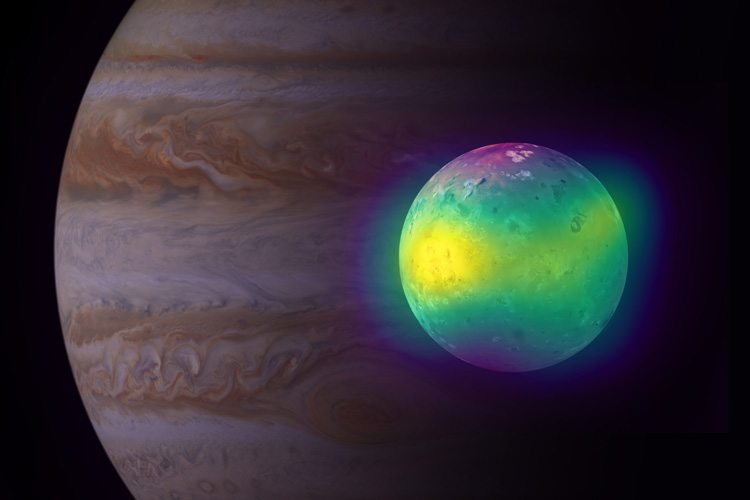Volcanoes fuel gaseous atmosphere on Jupiter's moon Io
What is creating the bubbling, gaseous atmosphere on Jupiter's moon Io? Scientists think they finally have the answer: volcanoes.
Io, the solar system's most volcanically active world, is one of four Galilean moons — the four largest moons of Jupiter, which were discovered by Galileo in the 17th century — and one of 79 total known satellites around the planet.
Io's atmosphere is known to be primarily made up of sulfur dioxide, but the source of this gas has long been a subject of debate.
“It was not known which process drives the dynamics in Io’s atmosphere,” Imke de Pater, graduate professor in the astronomy and earth and planetary science departments at the University of California, Berkeley, said in a statement. “Is it volcanic activity, or gas that sublimates from the icy surface when Io is in sunlight?"
A new study led by de Pater offers an answer.
"What we show is that, actually, volcanoes do have a large impact on the atmosphere,“ de Pater said.
Related: Amazing photos: Jupiter's volcanic moon Io
Get the Space.com Newsletter
Breaking space news, the latest updates on rocket launches, skywatching events and more!

Io's atmosphere is about a billion times thinner than our own planet's, which has allowed scientists to peer at the moon's surface, which is littered with lava lakes, liquid rock and sulfuric ice.
NASA's Jupiter-orbiting Juno mission, which will end next July, mainly observed Jupiter itself, so, instead of using an orbiting probe, de Pater has been studying Io using radio telescopes including ALMA (the Atacama Large Millimeter/submillimeter Array) in Chile and optical and infrared telescopes like the Keck scopes in Hawaii.
De Pater and her colleagues studied 30 years of observations of the moon's atmosphere and found that every 42 hours, as Io orbits Jupiter, the moon's atmosphere becomes seriously unstable. In this new study, the researchers found that, on March 20, 2018, as the moon was eclipsed by Jupiter, which caused temperatures to temporarily drop, sulfur dioxide gas levels seemed to drop dramatically.
The temperature drop likely caused the gas to, in essence, collapse back onto the moon's surface, the researchers determined. While Io's average surface temperature is about minus 202 degrees Fahrenheit (minus 130 degrees Celsius), this drop in temperature would have brought it down to minus 270 degrees F (minus 168 degrees C), which is below sulfur dioxide's freezing point.
The team further solidified these findings when, in September of 2018, after the moon emerged from the cold eclipse, sulfur dioxide emissions returned to where they were before. (This bounce-back happened quickly, in just about 10 minutes).
“As soon as Io gets into sunlight, the temperature increases, and you get all this SO2 ice subliming into gas, and you reform the atmosphere in about 10 minutes’ time, faster than what models had predicted,” de Pater said.
The researchers also found evidence of "stealth volcanoes," or volcanoes that emit no smoke or other particulate, in observations of low levels of sulfur dioxide in the moon's atmosphere. Additionally, the team noted widespread sulfur monoxide gas in Io's atmosphere in July, but only over active volcanoes.
With this data and by observing the moon going in and out of eclipse again, the team was able to see just how much of the moon's sulfur dioxide is caused by volcanism. 'When Io passes into Jupiter’s shadow, and is out of direct sunlight, it is too cold for sulfur dioxide gas, and it condenses onto Io’s surface. During that time, we can only see volcanically sourced sulfur dioxide. We can, therefore, see exactly how much of the atmosphere is impacted by volcanic activity," study co-author Statia Luszcz-Cook from Columbia University said in the same statement.
The team hopes to continue to study the moon, its atmosphere and volcanic activity to continue to solve mysteries about the world including what temperature its lower atmosphere is.
This work was described in a new study accepted for publication in the Planetary Science Journal.
Email Chelsea Gohd at cgohd@space.com or follow her on Twitter @chelsea_gohd. Follow us on Twitter @Spacedotcom and on Facebook.
Join our Space Forums to keep talking space on the latest missions, night sky and more! And if you have a news tip, correction or comment, let us know at: community@space.com.

Chelsea “Foxanne” Gohd joined Space.com in 2018 and is now a Senior Writer, writing about everything from climate change to planetary science and human spaceflight in both articles and on-camera in videos. With a degree in Public Health and biological sciences, Chelsea has written and worked for institutions including the American Museum of Natural History, Scientific American, Discover Magazine Blog, Astronomy Magazine and Live Science. When not writing, editing or filming something space-y, Chelsea "Foxanne" Gohd is writing music and performing as Foxanne, even launching a song to space in 2021 with Inspiration4. You can follow her on Twitter @chelsea_gohd and @foxannemusic.









